
McConnell Air Force Base
USINFO | 2013-10-15 16:51
|
McConnell Air Force Base Wichita Army Airfield |
|
| Part of Air Mobility Command (AMC) | |
| Located near: Wichita, Kansas | |
 Boeing KC-135 Stratotankers based at McConnell in formation as they taxi down a runway. |
|
| Type | Air Force Base |
| Coordinates | 37°37′23″N 097°16′02″W / 37.62306°N 97.26722°W / 37.62306; -97.26722 (McConnell AFB) |
| Built | 1941 |
| In use | 1941 – present |
| Controlled by | United States Air Force |
| Garrison | 22d Air Refueling Wing |
| Airfield information | |||
| IATA: IAB – ICAO: KIAB – FAALID: IAB | |||
| Summary | |||
| Elevation AMSL | 1,371 ft / 418 m | ||
| Coordinates | 37°37′23″N 097°16′02″W / 37.62306°N 97.26722°W / 37.62306; -97.26722Coordinates: 37°37′23″N 097°16′02″W / 37.62306°N 97.26722°W / 37.62306; -97.26722 | ||
| Website | www.mcconnell.af.mil | ||
| Map | |||
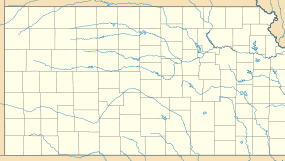 KIAB Location of McConnell Air Force Base |
|||
| Runways | |||
| Direction | Length | Surface | |
| ft | m | ||
| 1L/19R | 12,000 | 3,658 | Concrete |
| 1R/19L | 12,000 | 3,658 | Asphalt/Concrete |
| Sources: official web site[1] and FAA[2] | |||
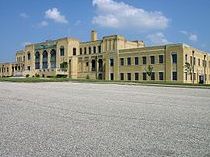
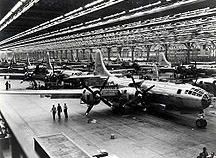
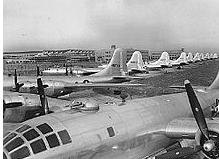
McConnell Air Force Base (IATA: IAB, ICAO: KIAB, FAALID: IAB) is a United States Air Force base located four miles (6 km) southeast of the central business district of Wichita, a city in Sedgwick County, Kansas, United States. The base was named in honor of Wichita brothers Fred and Thomas McConnell, both Air Force pilots and World War II veterans. It is the home of Air Mobility Command's 22d Air Refueling Wing (22 ARW), Air Force Reserve Command's 931st Air Refueling Group (931 ARG), and the Kansas Air National Guard's 184th Intelligence Wing (184 IW).
McConnell's primary mission is to provide global reach by conducting air refueling and airlift where and when needed. The Commander of the 22d Air Refueling Wing is Colonel Ricky N. Rupp, the Vice-Commander is Colonel Douglas K. Lamberth and the Command Chief is Chief Master Sergeant Michael H. Edwards.
Units
Major units at McConnell are:
-
22d Air Refueling Wing
-
22nd Operations Group (KC-135Q/T KC-135R) "Keeper of the Plains"
- 344th Air Refueling Squadron (Black fin flash)
- 349th Air Refueling Squadron (Blue fin flash)
- 350th Air Refueling Squadron (Red fin flash)
- 384th Air Refueling Squadron (Magenta fin flash)
- 22nd Maintenance Group
- 22nd Medical Group
- 22nd Mission Support Group
-
22nd Operations Group (KC-135Q/T KC-135R) "Keeper of the Plains"
-
931st Air Refueling Group (Air Force Reserve Command)
- 18th Air Refueling Squadron (The 18th ARS does not have any assigned aircraft. Rather, the squadron provides additional personnel to augment the active-duty personnel of the 22d ARW)
-
184th Intelligence Wing (Kansas Air National Guard)
- 127th Command and Control Squadron
McConnell Air Force Base was known during the first part of its existence as the Wichita Municipal Airport. Although the field was designed originally to serve only municipal civil airport needs, it had an Air Force connection almost from the beginning.
Origins
McConnell's history began in October 1924, when the city of Wichita hosted more than 100,000 people for the National Air Congress. The event was used by city planners to raise funds for a proposed Wichita Municipal Airport. The event was a success and ground-breaking ceremonies for the airport were held on 28 June 1929.
In August 1941, the Kansas National Guard 127th Observation Squadron was activated as the first military unit assigned to the Wichita airport. The unit's limited equipment included one BC-1A, one C-47, and four L-1 aircraft. This was the start of a cooperative relationship between the people of Wichita and military aviation.
B-29 Superfortress production
On 6 October 1941, the unit was ordered to extended active duty and remained an integral part of the United States Army Air Corps until 6 October 1945, with duty assignments in Tennessee and Okinawa. The airport, at that time, was located about six miles from the city of Wichita and comprised some 1,337 acres. The runways were adequate; were five runways each 150 feet wide; two were 7,500 feet, one 7,100 feet, one 6,000 feet, and one 4,500 feet in length. All had a wheel load capacity of 60,000 pounds. A parking apron with dimensions of 8,373 by 931 feet, and seven taxi strips were provided.
Other facilities at the airport, however, were meager. The field could boast of only one hangar and three small warehouses. No facilities were available either for troop housing or troop messing. No fuel storage facilities existed, and all such supplies were handled by commercial contract.
A lease between the federal government and the city was concluded and on 1 March 1942, the AAF Materiel Center, Midwestern Procurement District (Materiel Command) was established at Wichita Army Airfield. As soon as construction permitted, the headquarters of the district was established in the administration building of the municipal airport. By the end of 1942, due to the growth and expansion of the organization it occupied practically the entire building save for a few offices occupied by the CAA and airline companies, while some activities of the district were housed at the Boeing Airplane Company Plant No. 1, in Wichita.
Air Materiel Command's mission at the airport was to accept, service and coordinate the transfer of newly-produced Boeing B-29 Superfortress bombers to other installations. In addition, Ferrying Division, Air Transport Command's 4156th AAF Base Unit (Air Base) was organized. The new base unit had the mission of servicing, dispatching, and maintaining transient and locally based aircraft. The working personnel were entirely civilian, with a few officers in supervisory capacities.
On 11 October 1946, the 4156th AAF Base Unit was ordered to cease operations by the 30th of the month. Consequently, the remainder of October was spent in closing down operations and transferring property to Tinker Army Airfield, Oklaholma.
On 15 November the field was officially transferred to the District Engineer, Seventh Service Command at Omaha, Nebraska who assumed jurisdiction over the field, pending disposition, while the 4156th AAF Base Unit was discontinued on the same day. All military personnel were absorbed by Headquarters, Oklahoma Air Materiel Area (the successor of the Oklahoma City Air Technical Service Command).
Wichita Airport was returned to civilian jurisdiction, and it remained so until 1951.
Cold War
The Boeing B-47 Stratojet was the first swept-winged jet bomber built in quantity for any air force, and was the mainstay of the medium-bombing strength of the Strategic Air Command all throughout the 1950s. The Boeing plant at Wichita was shut down after World War II. However, on 3 September 1948, the first production order was placed for the B-47. Since Boeing's Seattle facility was already heavily committed to the KC-97 tanker and the B-50 Superfortress bomber, as well as to the conversion of obsolescent B-29 bombers to aerial tankers, it was decided that the production Stratojets were to be built at Boeing's factory in Wichita.
B-47 Stratojet training
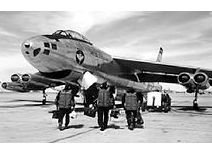
By the summer of 1950, Boeing was ready to turn out the first production models of the B-47, and the United States Air Force sought to make Wichita Airport a permanent military installation. Public hearings began to consider locating an Air Force base near the Wichita Boeing facilities, and the city of Wichita was awarded $9.4 million to build a new airfield for its own use, later to become known as Wichita Mid-Continent Airport. In addition, the production of the B-47 Stratojet bomber at Boeing made the airport a desirable location for the Air Force to conduct B-47 combat crew training.
On 31 May 1951, the USAF took title to Wichita Municipal Airport, and on 4 June the Air Training Command 3520th Combat Crew Training Wing was activated at the facility. To perform the training, the 3520th Combat Crew Training Wing was activated, and an ambitious building program totaling some $22,000,000 was begun.
In spite of the difficulty of building an installation and initiating an entirely new program simultaneously, the base developed into a highly specialized training center. Actually, there were two principal parts to the mission of the training center: aircrew training in B-47's and transition training in the same aircraft. A subsequent fluctuation of emphasis from one of those functions to the other reflected the varying demands of the Strategic Air Command. A more inclusive functional title was given the wing in June 1952 when it was redesignated the 3520th Flying Training Wing (M Bomb).
The Air Force was not the sole occupant during this period. In 1952 Wing Headquarters shared the Wichita Municipal Airport Terminal Building with four commercial airlines, Braniff, Central, TWA, and Continental, plus one private flying service: Executive Airways. These lines were located in the terminal building at the time of government occupation, and were permitted to operate on a temporary basis pending completion of the proposed new municipal airport.
Up to 1 April 1952 the activity at Wichita Municipal Airport was under the jurisdiction of the Flying Training Air Force. On that date it was transferred to the Crew Training Air Force, still remaining, however, in the Air Training Command.
By 1952 the Air Force had decided to make a permanent base of the quondam municipal airport. The government took the property by federal court action during the first half of 1952, thus becoming owner and no longer lessee. Reflecting official government ownership, Wichita Municipal Airport was re-designated the Wichita Air Force Base on 15 May 1953.
However, the name was changed to McConnell Air Force Base after less than a year in honor of Wichita brothers Fred and Thomas McConnell, both Air Force pilots and World War II veterans. Fred was killed in a private plane crash in 1945, while Thomas died in a bombing raid on Bougainville Island in the South Pacific.
Air Training Command was host at the base from 1951 through 1958, training B-47 aircrews. Strategic Air Command took control over the base on 1 July 1958 and the B-47 training mission. The 4347th Combat Crew Training Wing replaced the 3520th and the 42d Strategic Aerospace Division was activated on 15 July 1959. B-47 crew training continued at McConnell until 1 March 1963 when the 4347th CCTW was inactivated.
Titan II ballistic missiles
On 1 March 1962, Strategic Air Command stood up the 381st Strategic Missile Wing (SMW). Using McConnell as its base, 18 Titan IIICBM missile silos formed a ring from the northeast and south to the west on an irregular radius of 20 to 50 miles from the installation. This mission of deterrence would dominate base activity for the next twenty-four years until 1986 when the 381st Strategic Missile Wing was inactivated. Deactivation of all Titan II ICBM systems began in July 1982 and was completed in June 1987.
Share this page



















